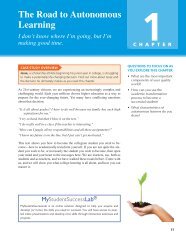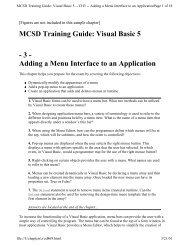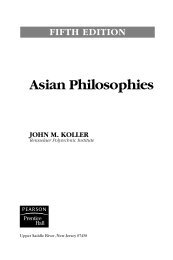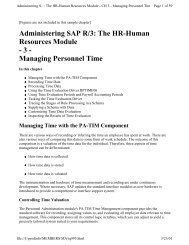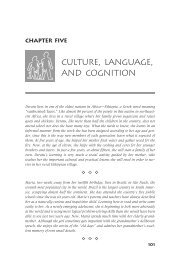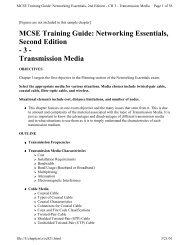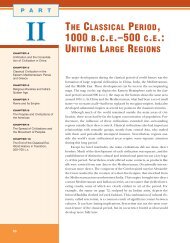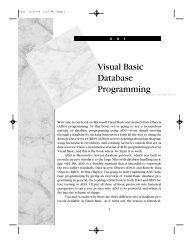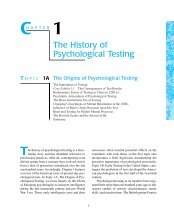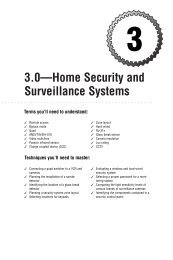SOCIAL PROBLEMS: A Down-to-Earth Approach, 8/e
SOCIAL PROBLEMS: A Down-to-Earth Approach, 8/e
SOCIAL PROBLEMS: A Down-to-Earth Approach, 8/e
You also want an ePaper? Increase the reach of your titles
YUMPU automatically turns print PDFs into web optimized ePapers that Google loves.
THINKING CRITICALLY About Social Problems<br />
Having an abortion solves the immediate problem of an unwanted<br />
pregnancy, but it also creates new problems. One is<br />
how <strong>to</strong> define the abortion. For those who view the fetus as nonhuman,<br />
this can be relatively simple. For those who view the fetus<br />
as a human, however (as well as for those with mixed views,<br />
which appears <strong>to</strong> characterize most women), the situation is<br />
more complicated.<br />
How do women cope? While abortions were still illegal (1971),<br />
I interviewed twenty-two college women who had abortions. These<br />
women used four major techniques <strong>to</strong> help them cope:<br />
1. Some women think of abortion as the lesser of two evils.<br />
They view abortion as preferable <strong>to</strong> having a child and<br />
ruining their own life or the lives of people they love; as<br />
preferable <strong>to</strong> shifting the responsibility for rearing the<br />
child on<strong>to</strong> others; or as preferable <strong>to</strong> resenting the child<br />
for having been born. One woman said:<br />
We saved ourselves and a child and very numerous<br />
other people from a lot of hurt because of this. And<br />
besides that, it was the only thing I could do—the<br />
only thing that I wanted <strong>to</strong> do, let’s put it that way.<br />
2. Some women look at abortion as a positive good in and of<br />
itself:<br />
(My mom) thought it’d be the best thing. . . . After<br />
my mom <strong>to</strong>ld me, I started <strong>to</strong> talk <strong>to</strong> my girlfriend,<br />
COPING WITH GUILT AFTER AN ABORTION<br />
(people answer in their own words) or closed ended (people choose from a list of prepared<br />
answers). An open-ended question might be “What is your relationship <strong>to</strong> the man who<br />
made you pregnant?” The woman would state the relationship in her own words. A closedended<br />
form of this question would ask the person <strong>to</strong> check an item on a list, such as husband,<br />
boyfriend, casual acquaintance, other. It is easier <strong>to</strong> compare answers <strong>to</strong> closed-ended<br />
questions, but open-ended questions tap a richer world, eliciting comments and even<br />
<strong>to</strong>pics that you might not anticipate.<br />
Documents ■ Written sources or records, called documents, can also provide valuable<br />
data about social problems. You might examine official records. Kristin Luker, for<br />
example, analyzed the records of 500 women who came <strong>to</strong> the abortion clinic that she<br />
studied. Or you might look at more informal records, such as journals, blogs, and letters.<br />
These documents can reveal people’s attitudes and provide insight in<strong>to</strong> how they cope with<br />
troubles.<br />
Observation ■ The fourth technique, observation, is just what the term implies: To<br />
use it, you observe what is occurring in some setting. You watch and listen <strong>to</strong> what is taking<br />
place and record or take notes on people’s conversations or the statements they make.<br />
You might use a tape recorder, but if recording will interfere with what people are doing,<br />
you will take notes instead, either while something occurs or afterward. If you use overt<br />
observation, you will identify yourself as a researcher, but if you use covert observation,<br />
the people in the setting will be unaware that you are studying them.<br />
and she decided it would probably be the best thing<br />
for me, <strong>to</strong>o. . . . I <strong>to</strong>ld (my boyfriend). . . . He thought<br />
that would be the best thing. . . . I always <strong>to</strong>ld myself<br />
that, you know, I’d probably get one if I didn’t<br />
get married, ‘cause <strong>to</strong> me that would be the best thing<br />
for me.<br />
3. Some women see themselves as having no responsibility<br />
because they had no choice:<br />
He (boyfriend) insisted that I do this. I was against<br />
it. . . . I knew that I didn’t want <strong>to</strong> . . . but when you<br />
have someone saying, “Well, this is what I want you<br />
<strong>to</strong> do”—and he didn’t want <strong>to</strong> get married, and he<br />
wouldn’t let me just have the child like I wanted <strong>to</strong><br />
do—so I really didn’t have a whole lot of choices. You<br />
know what I mean?<br />
4. Some women think in terms of a future pregnancy that will<br />
replace the “pregnancy-abortion”:<br />
The mistake is past, if it was a mistake. At any rate,<br />
we can do nothing about it now. Now we have <strong>to</strong> look<br />
<strong>to</strong> the future. In another year John and I will hopefully<br />
have the start of our own family. Thoughts of being<br />
a mother have entered my mind frequently since<br />
the abortion. I really look forward <strong>to</strong> that day!<br />
THE ROLE OF SOCIOLOGY IN <strong>SOCIAL</strong> <strong>PROBLEMS</strong> 19



